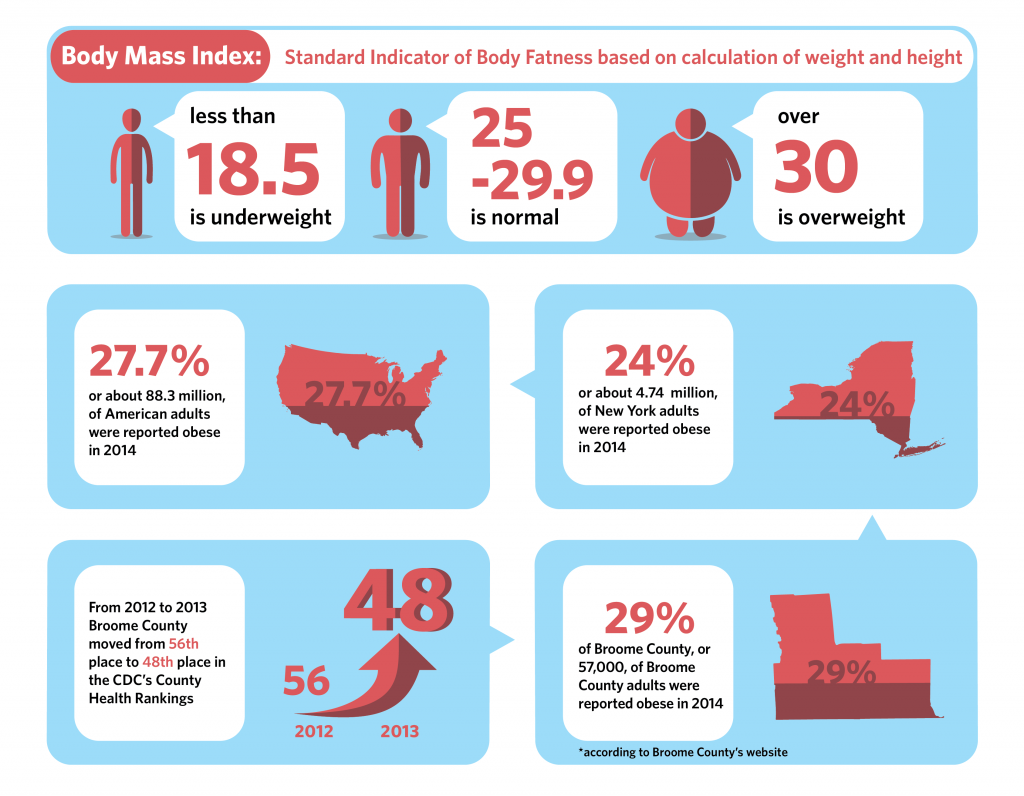The city of Binghamton and surrounding areas are taking steps to become healthier, as reports show that the percentage of obesity in Binghamton is slowly dropping.
In 2012, Gallup polling ranked Binghamton the second most obese city in America, coming in at a rate of 37.6 percent of adults, behind Texan metropolitan area McAllen-Edinburgh-Mission at 38.8 percent. The United States’ national average obesity rate was 26.2 percent, which meant roughly 82.3 million American citizens had a body mass index of 30 or greater. About 17,500 of those were in Binghamton.
Although results are still pending for 2014, the Centers for Disease Control and Prevention recorded a 1 percent drop in obesity levels in New York from 2012 to 2013, and over that time Broome County moved from 56th place to 48th place in the County Health Rankings.
Mary Griffin, the president of the Southern Tier Dietetic Association, said that although those rates are improving, it is hard to stay healthy in places around Binghamton.
“Exercise can be a challenge in rural areas such as the Southern Tier, where people may lack either safe places to exercise or transportation to safe places where they can exercise,” Griffin said.
Income can affect health, she added. In Broome County, 17.4 percent of the population lives below the poverty level, opposed to 15.8 nationwide percent and 16 percent in the state.
“If people are struggling with food insecurity, they often have to purchase the least expensive foods available to stretch their food dollars — and unfortunately, many of the less expensive foods in supermarkets can be high in fats and added sugars,” Griffin said.
New York has 539 nutrition policies that encourage healthy food choices and increased physical activity. Almost every public school in the state requires physical activity classes at least once a week. The state also regulates availability of health insurance coverage, nutrition facts and water fountains in schools.
Larger cities in the region, like Binghamton and Ithaca, also implement their own policies. According to Griffin, city councils televise public service announcements promoting healthy eating and exercise and various county agencies sometimes host free healthy cooking lessons.
Students are also working to make dietary changes on campus and in the wider Binghamton community.
Louis Vassar Semanchik, a senior majoring in biology, is an organizer for the Real Food Challenge, an organization that advocates for local agricultural economy and food that is bought at fair prices and served ecologically. He said the group is helping to provide accessible, locally grown food as opposed to commercially produced options.
“We are actively working with other campuses and the Real Food Challenge Organization to make sure that real food is affordable,” Semanchik said. “It is not fair that people do not have access to healthy food because they cannot afford it and are instead forced to eat food that induces adverse health conditions.”
Alexa Schmidt, dietitian of Sodexo Dining Services at BU, said the University is also making an effort to promote health. It recently joined the Partnership for a Healthier America, an initiative aimed at making campus healthier by adopting guidelines encouraging nutrition and physical activity.
Jessica Surdey, a personal trainer and an instructor in BU’s health and wellness department, said she has noticed plenty of resources to improve the health of people in Binghamton.
“We have beautiful outdoor places to exercise and move our bodies, as well as agriculture and fresh produce like fruits and vegetables,” Surdey said. “It’s less about not having the resources and more about time management skill and putting health as a priority.”



